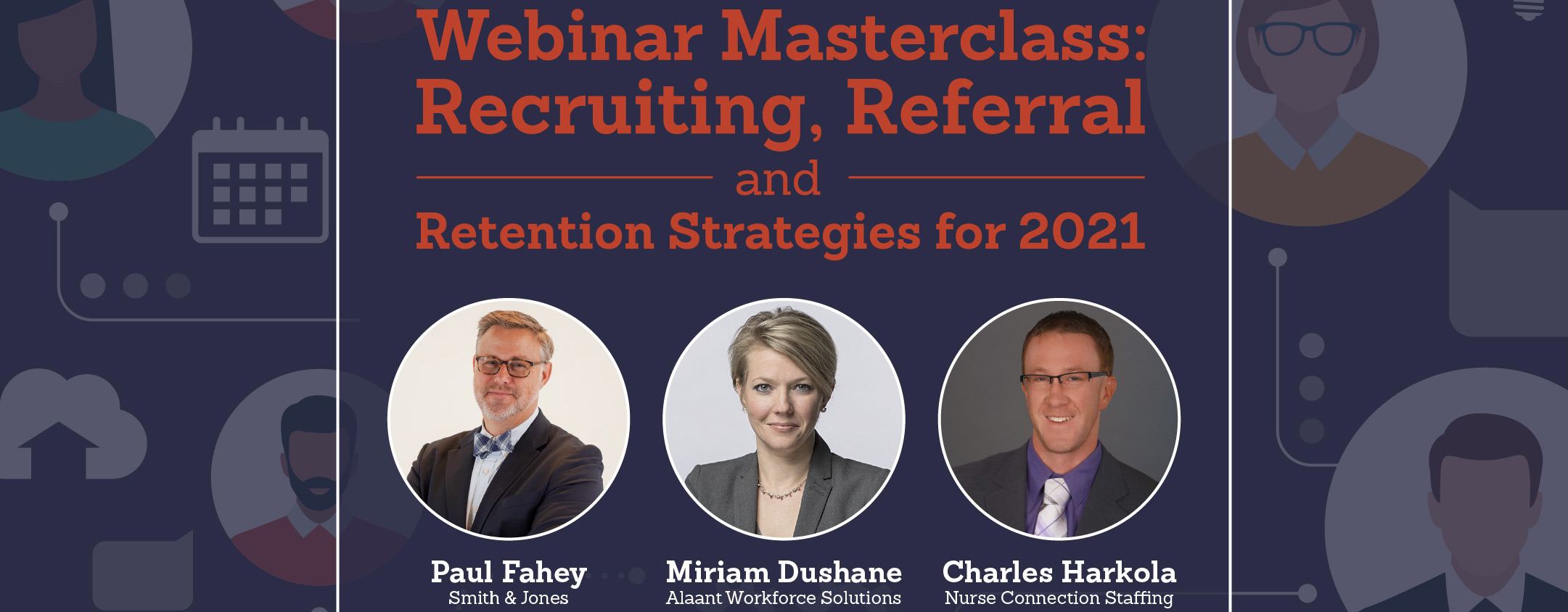Healthcare Recruiting, referral and retention strategies for 2021 – Recap
Now that COVID-19 has added yet another layer of stress on both your internal team and job seekers, how do you continue to build the best team?
Even before the pandemic, one major concern for hospitals and health systems has been recruiting and retaining the best staff. These high-stress jobs need to have a strong support system to stay sustainable.
On January 20, Smith & Jones/Overit Vice President Paul Fahey discussed this topic with two top healthcare recruiters, Miriam Dushane, Managing Partner of Alaant Workforce Solutions, and Charles Harkola, Director of Sales, Marketing & Recruiting with Nurse Connection Staffing.
Watch the full panel here.
How do you build brand ambassadors?
Before your employees can become ambassadors for your brand in the outside world, you must first look within. Are they bought into your vision, values and culture? If they can’t articulate why your organization is special or different, how can they tell others about it? Do you have a system for on-going employee recognition that makes people feel appreciated? Make sure your internal culture is strong before starting any referral initiatives.
Next, when asking for referrals, don’t just send a quick email to your staff and think you’re done. Miriam and Charles recommended reaching out to a handful of your top performers.
• Talk to them directly and actively follow up.
• Think about setting up an incentive program.
• Be intentional: Don’t ask just anyone for a referral. Think about the employees who are doing the best job of living your brand.
• Make sure it’s a diverse group of people, so your incoming recruits will be more likely reflect that diversity.
Another point the recruiters made is to not be afraid of your employees’ using social media. In fact, you should be using it to build your brand. Yes, sometimes negative comments will be made. But these underlying problems should be addressed and handled offline.
You can also use social media as an extension of your employee recognition, to highlight employees and their stories for both organic posts and even in ads as well. A great idea for a video campaign can be something as simple as asking employees, “Why do you do what you do? Why do you do it here?” Not only are you able to make your employees feel special, but you can also get the attention of both active and passive job seekers who may be following your page, and show them why you’re a great place to work.
Ongoing relationship building – Whether they become your employee or not
Recruiting doesn’t end when you hire someone. They’re now a representative (and, hopefully, a brand ambassador) for your company. In-person and anonymous surveys are a great way to get feedback and data on your hiring process and company culture. But don’t wait until someone is leaving to ask for their feedback. Miriam suggests creating an onboarding survey to learn why they were interested in the job in the first place and ask how the application and interview process went while it’s still fresh in their mind. Charles suggests check-ins at 30, 60, and 90 days (which can also be great opportunities to ask for referrals).
And what about people who had potential but weren’t hired? You should continue to be in touch and follow up with them to keep them in the pipeline for the next opportunity. Keep them engaged by keeping them in your email list, asking to follow you on social, and touching base every six months or so to see if they’re still job searching and if their resume has changed. By nurturing a good relationship, even if you’re never able to place them, they could still become an advocate for your brand because of how they were treated.
Final thoughts
The pandemic has given healthcare organizations an interesting opportunity to build brand through employee recognition (think about all the artistic “Healthcare Heroes” videos you’ve seen throughout the course of the past year). But we also have to do more with less. The discussion concludes with this sentiment: “Know your market. Know your audience. Know your metrics. But be open to change as well.” Know which channel your best applicants are coming from, and prove it to management.
Need help with an active recruitment strategy? Get in touch.

